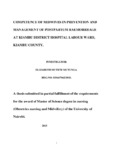| dc.contributor.author | Mutunga, Elizabeth M | |
| dc.date.accessioned | 2016-04-27T06:33:34Z | |
| dc.date.available | 2016-04-27T06:33:34Z | |
| dc.date.issued | 2015 | |
| dc.identifier.uri | http://hdl.handle.net/11295/95104 | |
| dc.description.abstract | Introduction: Post-partum haemorrhage (PPH) is a leading cause of maternal mortality
worldwide and is responsible for 34% of maternal deaths in Africa. It is defined as blood loss of
more than 500 ml following vaginal delivery or more than 1000 ml following caesarian delivery.
Blood loss can occur during the first 24 hours (primary PPH) or from 24 hours up to 6 weeks
after delivery (secondary PPH). Primary PPH classified by site is either placental or extraplacental
bleeding. Secondary PPH is abnormal or excessive bleeding from the birth canal
between 24 hours and 6 weeks postnatal.
Objectives: To establish midwives competencies in prevention and management of PPH: the
knowledge and skills the midwives possess in prevention and management of PPH.
Study design: Descriptive study.
Setting: The study was conducted at labour ward of Kiambu district hospital.
Methods: After approval by UON/KNH ethics and research committee and permission from
Kiambu District Hospital management, the principal investigator and one research assistant
collected data by use of structured questionnaire and an observation checklist after obtaining
consent from eligible participants. Data was stored in a password protected computer and a flash
disc under the safe custody of the principal investigator. Data was analyzed by use of statistical
package of social and scientists (SPSS) version 20.0.
Study results: During the study period from July to August 2015, 22 midwives working at
Kiambu district hospital labour ward filled the questionnaire and 18 of this were observed while
conducting deliveries. All midwives were females, 90.9% were KRCHN, 59.1% had worked in a
labour ward setting for 0-4 years and 68.2% were trained on active management of third stage of
labour(AMSTL) which is key in prevention of PPH. Knowledge on components of AMSTL was
100% for administration of uterotonics, 95.5% for controlled cord traction and 86.4% for uterine
massage.77.3% had knowledge that administration of uterotonic should be within a minute of
delivery of the infant but on observed deliveries only 13.6% managed to administer within this
time .Uterotonic supplies were always present and physiological management of third stage of
labour was not practiced. Competence on AMSTL practice on observed deliveries was 44.4%.
Conclusions: This study has yielded new knowledge on midwives knowledge and skills on
prevention and management of PPH. Midwives had adequate knowledge on prevention of PPH
(overall 90%) but need improvement in actual performance (skills) since majority of the mothers
missed the preventive benefit associated with administration of prophylactic uterotonic within a
minute of delivery of the infant.
Recommendations: Ensuring that midwives get current updates through the continuous
professional development programme and availing guidelines on active management of third
stage of labour at the labour ward would go a long way in improving performance. | en_US |
| dc.language.iso | en | en_US |
| dc.publisher | University of Nairobi | en_US |
| dc.rights | Attribution-NonCommercial-NoDerivs 3.0 United States | * |
| dc.rights.uri | http://creativecommons.org/licenses/by-nc-nd/3.0/us/ | * |
| dc.title | Competence of midwives in prevention and management of postpartum Haemorrhage at Kiambu District Hospital labour ward, Kiambu County | en_US |
| dc.type | Thesis | en_US |
| dc.description.department | a
Department of Psychiatry, University of Nairobi, ; bDepartment of Mental Health, School of Medicine,
Moi University, Eldoret, Kenya | |



